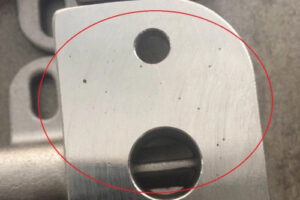Addressing Die Casting Defects: Causes, Analysis, and Solutions

Die casting is a widely adopted manufacturing process known for its efficiency, precision, and versatility. However, despite its many benefits, the production of flawless die castings can sometimes be challenging due to the occurrence of defects. This article aims to provide an overview of common die casting defects, their causes, and effective solutions to address them, ensuring high-quality castings.
1. Porosity:
Porosity is a prevalent defect in die casting that refers to the presence of voids or trapped gases within the casting structure. It can occur as either gas porosity or shrinkage porosity.
Causes:
– Gas porosity arises from the entrapment of air or other gases during the injection process. It can result from high turbulence, improper gating, or inadequate venting.
– Shrinkage porosity is caused by the solidification shrinkage of the molten metal during cooling. It primarily occurs due to improper gating, inadequate feeding, or alloy composition.
Solutions:
– Optimize die and gating design to ensure smooth and controlled metal flow, reducing turbulence and air entrainment.
– Implement proper venting to allow trapped gases to escape during the injection process.
– Use degassing agents and melt treatments to minimize gas content.
– Adjust alloy composition and cooling rates to reduce shrinkage porosity.
2. Cold Shut:
Cold shut defects occur when two or more metal flows fail to fuse together properly, resulting in incomplete casting sections or visible lines.
Causes:
– Insufficient metal injection velocity or pressure can prevent proper fusion of molten metal streams.
– Inadequate gate area or design can hinder metal flow, causing incomplete fusion.
Solutions:
– Optimize injection velocity and pressure to ensure sufficient force for metal fusion.
– Modify gate size and design to facilitate improved metal flow and fusion.
– Monitor and control die temperature to achieve proper metal flow and fusion.
3. Flash:
Flash defects occur when excessive molten metal escapes through parting lines or gaps in the die during the casting process, resulting in unwanted protrusions on the final product.
Causes:
– Excessive injection pressure or velocity can cause molten metal to escape through die gaps.
– Worn or damaged die components can create openings that allow metal leakage.
Solutions:
– Control injection pressure and velocity within appropriate ranges to prevent excessive metal leakage.
– Conduct regular maintenance of dies to repair or replace worn components and eliminate gaps.
4. Surface Imperfections:
Surface imperfections encompass various defects such as surface roughness, pits, and blemishes that can affect the visual appearance and functionality of die castings.
Causes:
– Improper die lubrication or release agent application can lead to incomplete filling, resulting in surface defects.
– Contaminants, impurities, or foreign particles in the molten metal can cause blemishes or pitting on the surface.
– Inadequate die temperature control can affect metal flow and result in irregular surface finish.
Solutions:
– Ensure proper die lubrication and release agent application to facilitate smooth metal flow and complete filling.
– Maintain strict quality control over raw materials to minimize the presence of contaminants.
– Implement precise die temperature control to optimize metal flow and achieve desired surface finish.
Conclusion:
Die casting defects can impact the overall quality and performance of castings. By understanding the causes of common defects and employing appropriate solutions, manufacturers can minimize their occurrence and deliver high-quality die castings. It is essential to emphasize the significance of proper process design, material selection, and maintenance practices to achieve defect-free castings and enhance customer satisfaction. Continuous improvement and effective defect analysis techniques should be implemented to optimize the die casting process for consistent quality and productivity.







